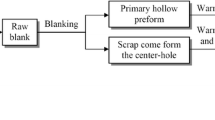Abstract
This paper describes a numerical and experimental investigation of preform design in non-axisymmetric warm forming in order to achieve a large reduction in the volume of flash. A titanium TA2 watch-case-like component was used as an example. Sixteen different shapes of hollow preforms were specially designed for finite-element simulation. Their diameters of the center-holes were designed based on the values of the diameters of end-face configurations of punches and ejectors. The corresponding thicknesses of the preforms were determined by the assumption of constant volume. Under the same processing conditions, the diameter of center-hole of the preform should be the inner diameter of ejector such that its volume of flash was able to be greatly reduced to 6% of the volume of the formed component whereas the volume of flash was approximately 25% in the conventional implementation. Experiments were subsequently performed to verify the simulation results. This study rationally demonstrates the success of the preform design for warm forming of non-axisymmetric components, and provides great improvement in the utilization of material in the bulk forming process. Thus, the achievement is a tremendous saving in materials, more than a fourfold, particularly for these rare and expensive alloys.
Similar content being viewed by others
References
Donachie MJ (2000) Titanium: a technical guide. ASM International, Materials Park, Ohio
Mitchell A (1998) Melting, casting and forging problems in titanium alloys. Mater Sci Eng A-Struct Mater Prop Microstruct Process 243:257–262
Prasad YVRK, Sasidhara S (1997) Hot working guide: a compendium of processing maps. ASM International, Materials Park, Ohio
Prasad YVRK, Seshacharyulu T (1998) Processing maps for hot working of titanium alloys. Mater Sci Eng A-Struct Mater Prop Microstruct Process 243:82–88
Fujikawa S, Yoshioka H, Shimanmura S (1992) Cold and warm forging application in the automotive industry. J Mater Process Technol 35:317–342
Hirschvogel M, Dommelen HV (1992) Some applications of cold and warm forging. J Mater Process Technol 35:343–356
Srinivasan K, Venugopal P (1993) Warm open-die extrusion of Ti-6Al-4V. J Mater Process Technol 38:265–278
Biswas SK, Knight WA (1975) Preform design for closed die forgings: experimental basis for computer aided design. Int J Mach Tool Des Res 15:179–193
Park JJ, Rebelo N, Kobayashi S (1983) A new approach to preform design in metal forming with the finite element method. Int J Mach Tool Des Res 23:71–79
Sheng S, Guo LY (1992) Preform design of axisymmetric forgings based on reverse simulation technique of die forging process. J Mater Process Technol 34:349–356
Han CS, Grandhi RV, Srinivasan R (1993) Optimum design of forging die using nonlinear finite element analysis. AIAA J 31:774–781
Oh SI, Yoon SM (1994) A new method of design blockers. Ann CIRP 43:245–248
Lapovok RY, Thomson PF (1995) An approach to preform design. Int J Mach. Tools Manuf 35:1537–1544
Takemasu T, Vazquez V, Painter B, Altan T (1996) Investigation of metal flow and preform optimization in flashless forging of a connecting rod. J Mater Process Technol 59:95–105
Vazquez V, Altan T (2000) Die design for flashless forging of complex parts. J Mater Process Technol 98:81–89
Hwang SM, Kobayashi S (1986) Preform design in disk forging. Int J Mach Tool Des Res 26:231–243
Zhao G, Zhao Z, Wang T, Grandhi RV (1998) Preform design of a generic turbine disk forging process. J Mater Process Technol 84:193–201
Sabroff AM, Boulger FW, Henning HJ (1968) Forging materials and practices, battelle memorial institute, Columbus, Ohio
Sheridan SA (1972) Forging design handbook. ASM, Metals Park, Ohio
Semiatin SL (1988) ASM Handbook Vol. 14 Forming and Forging. ASM, Metals Park, Ohio
Altan T, Nagpal V (1977) Impression and closed-die forging. Int Met Rev 22:322–340
Lange K, Meyer-Nolkemper H (1977) Close-die forming. Springer-Verlag, Berlin (In German)
Fluhrer J (2006) DEFORM-3D Version 6.0 User’s Manual, Scientific Forming Technologies Corporation. Columbus, Ohio
Author information
Authors and Affiliations
Corresponding author
Rights and permissions
About this article
Cite this article
Kong, T.F., Chan, L.C. & Lee, T.C. Numerical and experimental investigation of preform design in non-axisymmetric warm forming. Int J Adv Manuf Technol 37, 908–919 (2008). https://doi.org/10.1007/s00170-007-1036-6
Received:
Accepted:
Published:
Issue Date:
DOI: https://doi.org/10.1007/s00170-007-1036-6



